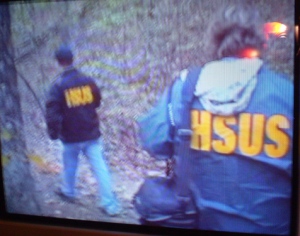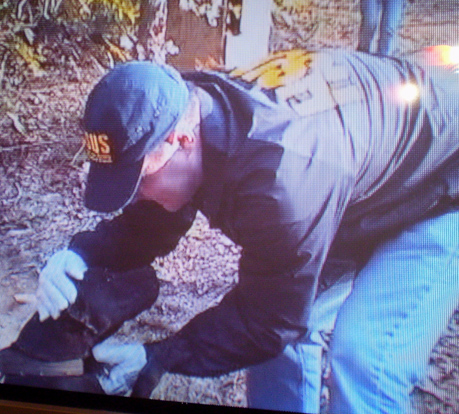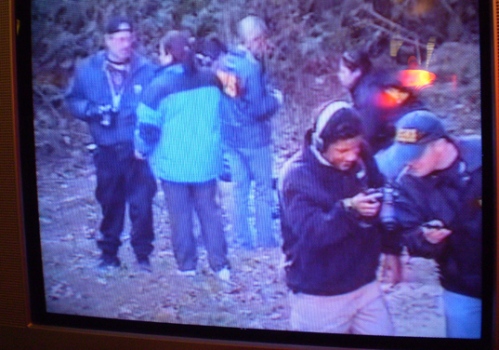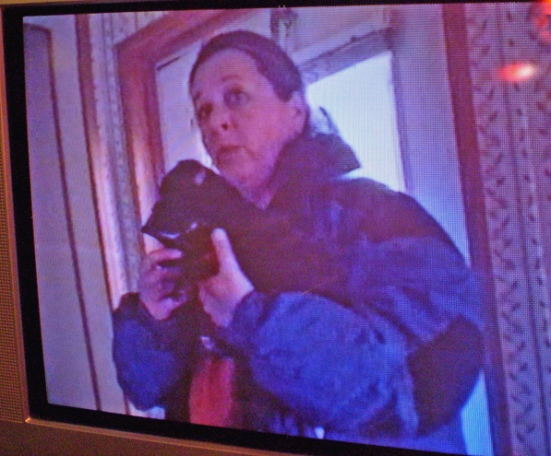Join the Crusade Against HSUS Anti-pet laws and Pass it Forward to Everyone You know, and post this link to any sites that you can, and be sure to realize that HSUS and friends have 6 laws pending before CA legislature, and all of them are garbage. Garbage. All need to be trashed and kicked out.
URGENT: AB243 MUST BE OPPOSED! AB243 Opposit AUG09 pdf
Do you own animals?  Then you don’t want to support HSUS (Humane Society of the United States) which uses both JP Goodwin (a criminal felon) and Michael Vick (dog torturer, criminal felon, from dog fighting) and probably others that we don’t know about right now. Please read what is posted here, as this is your warning to watch out…. HSUS is aiming mostly for dogs, kennels [search warrants, possibly forcible]  and horses to seize, also using search warrants. Below, we see the helper with HSUS seizing one of the pups taken ………….. helper is supposedly a vet for ASPCA if we understand it correctly.
HSUS is telling Californians that anyone ‘accused’ of animal abuse even if acquitted, and thus exonerated— that their animals should be FORFEITED…………… HSUS has a pending law for that. You didn’t know????
 HSUS will have their cronies make those errant warrants to seize your animals, and even if you make it out as “not†guilty, you still pay thousands to get back what was yours from the start, and then you face (if law passes) either another hearing or another administrative determination whereby, you cannot be innocent and must not be around animals, whereupon your animals can be forfeited ANYWAY. Â
Unfortunately we can’t get this so it’s viewable online. But see below. The 6 proposed laws:
All Californians need to get up to speed on the 6 laws pushed by HSUS and proponents, [AB1122, 241, 242, 243, SB250, SB318], operating under different “shell†corporate names, where all of the laws work together to trigger one of the other laws proposed, basically to either seize animals, have them forfeited, or find you guilty even after you are acquitted.Â
AB242…will trigger 250, 243 and 318; can easily spur CPS (child protective services) into seizing kids from homes and put into fostercare, this happened already in San Francisco when a rescued dog went after another smaller dog; triggers forfeiture. Your animal in altercation with another animal will trigger this law. Don’t care how it is worded, that is the reality. You get abuse citation.
SB250…will trigger 243, possibly 318; assumes natural state animals (unsterilized) are unsafe, penalty for any violation is sterilization, and may trigger forfeiture as well. Requires all animals sterilized at 6mo. [Just a re-run of AB1634 but worse] Opposed by Dept. of Finance!
AB241…will trigger or can trigger 250, 243, 318; arbitrary number used to indicate “abuse†without it being abuse, just for a kennel owning more than X number of natural state animals, even pups/kittens would count, and boarding kennels/handlers have no exceptions. That means a third party can lose their dog because it was at a handler’s kennel, which might be over the X limit. Automatic forfeiture of animals; has nothing to do with abuse; would trigger 250 which would trigger forfeiture as well. Opposed by Dept. of Finance http://www.dof.ca.gov/legislative_analyses/LIS_PDF/09/AB-241-20090813120605PM-AB00241.pdf
AB1122…will trigger 250, 243 and possibly 318, impossible to amend, should be thrown out completely. Is categorized under “abuse†statute.  Would make “sales†illegal and therefore “abuse† but if a non profit or animal rescue sells, it would be legal, with no ramifications for “abuse.†Makes legal conduct illegal, such as transferring an animal in any parking lot in the entire state. A volunteer private person using the Lexus car dealership (with sponsorship) to get homes for 15 cats would be illegal. Opposed by Dept. of Finance.
AB243… can trigger forfeiture after acquittal, and applied to search warrants if passed. So exoneration via the courts will mean nothing, if they can confiscate and seize your animals anyway, plus you pay for it as well? Problem nationwide is, search warrants are being used for barking complaints. Forcible entry is used for no kennel license (for 5 dogs) and etc.   An obvious ploy to kill more animals, seize more animals, and for proponents to sell more seized animals themselves. [See posting on forcible entry warrant on this blog]
SB318.. would allow forfeiture proceeds to go to non govt. proponent private corporations rather than the State, likely violates the CA constitution, and proceeds would be given to these groups even if all they do is kill all the animals and not save them. There is no cap on the proceeds, so it could amount to windfall financials to proponent groups, just for killing animals. Since HSUS makes a habit of advocating to kill all pitbull dogs (like the Vick dogs, which were mostly saved) and has helped Louisiana pass a law whereby “seized†alleged fighting dogs can be killed immediately [claiming they are considered contraband]— so that a conviction of up to 10 years of hard labor would have to be defended after all the dogs had already been killed by the government?  [See below for LA code]
Proponents such as HSUS, ASPCA, local humane societies, etc, Â can lobby District Attorneys to get forfeiture for their own groups, which are private corporations, not the State govt. This means the proponents groups are an interested party financially, and they should have nothing to do with being witnesses or have any bearing on the defendant. Yet surely that is what will happen, then they will ensure defendants are convicted, so they can gain financially from the forfeiture.
It looks like HSUS helped get a law passed in Louisiana awhile back, so that “seized†fightin’ dogs are deemed  contraband, and then can be euthanized “AS SOON AS POSSIBLE.â€Â Notice it did not say seized dogs, where owner is convicted, or where owner is proven guilty. Nope. Just seized. The apparent issue with this is that the alleged dogs cannot be contraband unless you can prove it.
But Not in Louisiana,  One doesn’t need to be proven guilty to have the dogs all killed. A picture of a dead dog must be good enough?  So just seize dogs, kill them, make allegations, oh well too bad, so sad? Apparently the crime of having the “fightin†dogs may carry a 10 year sentence of hard labor, BUT they don’t need the dogs for evidence.
That is from the Louisiana animal cruelty statutes Section 102.6 A(2)…….. and they normally don’t even go to trial, because they simply don’t have the evidence. HSUS raids need only swarm down like locusts upon the alleged owners, seize everything in sight, and then kill, kill, kill— and not worry about anything else.   Â
AND since HSUS gets the prosecutors to delay the cases for years, the statute of limitations runs for filing a civil 1983 claim, as you cannot bring a Federal action for the issue if your case has not been concluded finding you acquitted or you have not been otherwise exonerated!  Most statute of limitations do not go much over three or four years [many are only one year, barring tolling] , so if you can’t get your case filed before that, you are SOL. HSUS knows that of course! Note– we are not saying dog fighting (if actually done) is a good thing. Of course it isn’t. But one should have to prove the elements of a crime, not kill off the evidence beforehand, and with a law that allows it to boot!!!Â
People of California— you need to contact your senators immediately in August 2009, while we still have a chance to flatten the tires of the HSUS Party Team as they take us all for idiots and make laws that say we are all guilty even if proven innocent, where RAIDS are the order of the day, and FORCIBLE warrants are used when there is no cause for such warrants!!!!! [See prior posting on that subject with picture of warrant from SoCal]
PHOTOS …………HSUS…………RAID………..
So let’s look at the promised HSUS dog raid, taking 12hr time, 9am to 9pm, where HSUS, ASPCA and many others, descended upon the family of the Woodall’s on their shaded property in Georgia, so they could seize those  â€fightin’ dogsâ€â€¦â€¦â€¦â€¦. Maybe you can tell yourself (if you know dogs very well) that no one in their right mind would put their face 5 inches from a vicious “fightin’ dog†………nor would one bend directly over the head of the “dangerous  fightin’ dogâ€â€¦â€¦â€¦â€¦. nor would one be able to put a [red colored] loose lead on the “fightin’ dog’s†neck, and the “fightin’ dog†just walks ahead without even pulling out of the lead. Nor would the “fightin’ dog† puppies, [HSUS apparently claimed both pups qualified], that they seized–elicit the smile on the seizer’s face as she held both pups in her arms.Â
People–the time has come to realize that all that crap you hear/see that HSUS puts out about RAIDING RAIDING RAIDING is not all what it seems.
Think very hard when you view these photos. We have a lot more of them, could that be your family, your kids, your property? You better believe it.Â
THE PROPOSED LAWS BY HSUS AND FRIENDS WILL LEAD TO
NOT ONLY MORE ABUSEÂ OF THE LEGAL SYSTEM,
BUT MOREÂ ERRANTÂ SEARCH/SEIZURE, MORE RAIDS, AND MORE FORFEITURE.
MORE ABUSE CITATIONS, AND MORE PENALTIES FOR LEGAL ACTS
THAT ARE TERMED “ABUSEâ€Â – WHEN THEY ARE NOT ABUSE.Â
Remember–they are doing WARRANTS for raids- seizure for “barkingâ€
It happens with increasing, and unwarranted frequency. HSUS is trying to turn up the heat to make it appear as if every neighborhood needs raiding. JP Goodwin leading the pack, JP Goodwin getting close and personal with dangerous “fightin’†dog, the ASPCA rig (white vehicle with overhead cab) and others. These photos are taken directly from videos played on the TV and they all will show fragmentation. There were no dogfighting charges filed against owners, and the court ordered all the seized dogs to be released in less than 2 weeks. Instead, the animal control kept the dogs for 4 months in a shelter almost 5 hours away!!
We have spoken personally with the raided party, who enters dogs in weight pull, treadmill, and conformation.
——————————————————-


 We can’t load many more pics due to excessively slow time loading. We will put more pics up and try and get them loaded on Photobucket. Have a lot of pictures taken directly from the video shoot.
We can’t load many more pics due to excessively slow time loading. We will put more pics up and try and get them loaded on Photobucket. Have a lot of pictures taken directly from the video shoot.
Directly above, is the raiding and seizure of 2 puppies. Puppy seizer smiling, but you know how those “fightin’ dogs†are. Vicious! I am so scared!
This is a sweep view out on the property. Most of the area is heavily shaded.
Above, JP Goodwin being filmedwith HSUS Dream Team, pretending they are movie stars.

Now does that look like a vicious dog being led away to be killed on that loose lead? Or is that just another poor family dog being seized by HSUS? The picture is cut off because it was taken from inside the home, where HSUS and crew forced the family to stay inside from 9am to 9pm on the RAID day (and night.)
Below, the kids with one of  their dogs, which usually sleeps inside on the bed.

 
Lower right is JP Goodwin yet again, with cohort. Lots of camera crews, and people from different groups, including but not limited to ASPCA. HSUS financed an ASPCA rig just for seizing dogs in kennel or alleged “fightin†raids. Maybe the one in the picture which is ASPCA (hard to read the ASPCA but it’s definitely there on the truck) is one paid for by HSUS. Maybe that $ 250,000 donated to ASPCA is used to round up dogs. Or maybe it’s just used to fleece the public?
Looks to us like they were all sorely disappointed that they had failed in 12hr to actually find any “fightin†dogs but they seized them ALL anyway.



